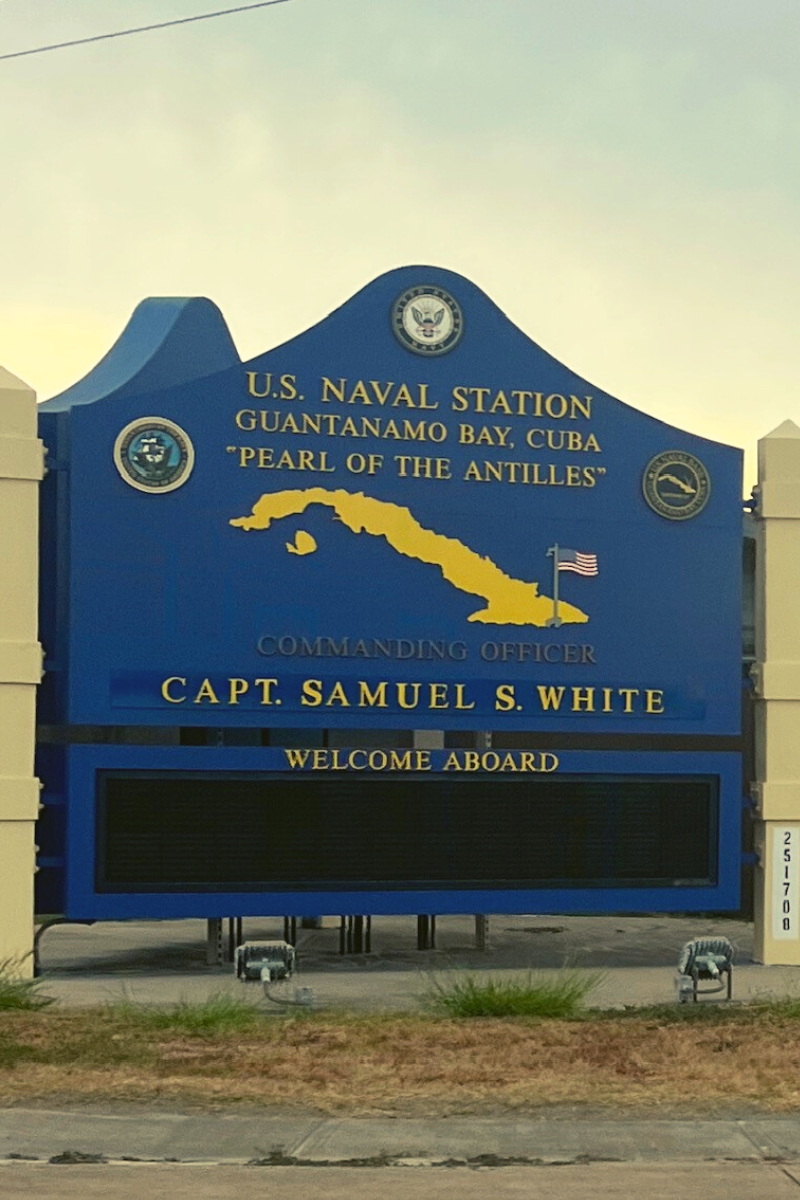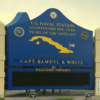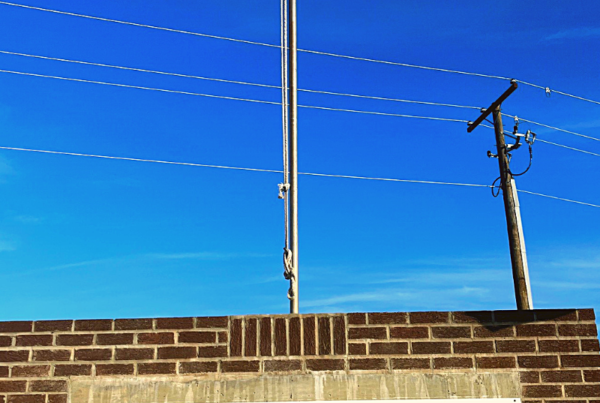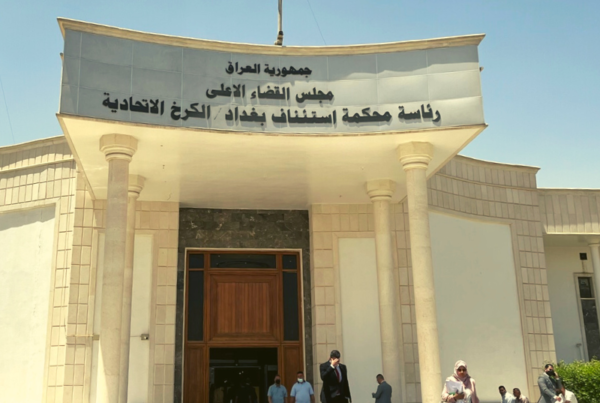GUANTANAMO BAY, Cuba – In many ways, Guantanamo Bay, Gitmo or GTMO, has emerged as the stuff of myth, mayhem, and melancholy. It reputes as one of the more notorious garrisons in the world, once teeming with hundreds of alleged terrorists characterized as the “worst of the worst,” apprehended amid the frantic aftermath of the September 11 attacks.
Critics have called for its closure for years, while proponents have proclaimed it needs to remain active for our national security purposes. Emotion drives both arguments, but what are the facts?
To get there as a civilian (following official approval from the Office of the Secretary of Defense, a vaccination card and negative PCR COVID test) entails a civilian charter flight from Andrews Air Force base in Maryland. The approximately three-hour flight lands on the eastern island named Leeward and then necessitates a ferry ride to the central base of Windward, the western portion of the Bay.
Situated on a parcel on the far edges of the 45-square-mile naval base, the detention facility is often just deemed “JTF,” aka “Joint Task Force,” which presides over multiple prison slabs with infamous names like Camp X-Ray and Camp Delta. It is a pronounced change from the more sanitized-sounding “Camps 1,2,3” through to the shadowy and top-secret Camp 7, home to the high-value detainees, including the alleged 9/11 masterminds in the years after the confinement was opened.

The purpose of my Gitmo venture is courtroom reporting – aka terrorism pretrial hearings inside Camp Justice – and I am informed in writing that “tours of the detention facilities are not available.” It seems these were commonplace for journalists until 2019 when the Navy Rear Admiral who gave interviews was fired and replaced.
However, given the detention compound is the focal point of the base, in addition to the accompanying military commission proceedings, I try my chances. A representative for United States Southern Command (SOUTHCOM), which oversees JTF-GTMO, promptly and politely responds via email: “at this time, we are not offering visits to JTF- GTMO or detention facilities due to Operational Security and COVID 19 mitigation protocols, nor are interviews currently being conducted.”
I am left only to imagine the kind of peculiar chaos that would have simmered over the spit of land at its height, a tableau of searing tangerine jumpsuits donned by an array of men alleged to have American blood on their hands, and in addition, alleged to have endured inhumane interrogation sessions referred to by some as “enhanced interrogation techniques” (EITs) and by others as torture.
Since 2002, roughly 780 individuals suspected of terrorist involvement and belonging to some 50 different countries have passed through the military prison on foreign soil, thus they are not subject to U.S. law and its constitution. Hundreds have been released without charge, and some transferred to third countries.
“They (detainees) would throw their feces at you when you walked by,” one former intelligence official recounts before my journey. “At that time, it was the only way they felt that they could protest.”
Today, 36 are left. Nineteen have been cleared for release by the U.S. government but remain at GTMO.
In spite of this, the detention issue is not the focus point of routine conversations. I am reminded during an introductory orientation that Guantanamo is essentially made up of multiple military missions aside from JTF, answerable to different chains of command, including the Naval hospital and Naval station.
Indeed, daily life outside the JTF bubble goes on. After all, next year will mark a century since the United States signed an agreement with a newly independent Cuba to lease the island indefinitely.
Lovely, faded white houses dot the horizon on small hills overlooking the lapping blue seas, home to some 6000 Joint Services personnel, Department of Defense civilians, family members, contract personnel, and local and foreign national employees stationed in Guantanamo. (Around 1500 personnel are assigned to the penitentiary of fewer than 40 detainees.)
In contrast, other workers live in more standardized, box-like structures in various areas. There is a McDonald’s restaurant poised on the main road that slices through the base, as well as a Chapel, bowling alley, dive shop, a giant gym with an outdoor track, an Irish pub, a few outdoor cinemas, and a handful of bars that ooze with alcohol and energy the moment the weekend ascends.
GTMO boasts only one proper supermarket, the NEX. It is accompanied by a Subway, a beauty salon, and a souvenir store bursting with hats, shirts, key rings, and coffee cups. A symbol of the Cuban flag crossed with the U.S flag seems a souvenir staple, but I learn there are next to no Cubans on the Cuban land. There is no discernible Cuban flavor about the Bay either – no traditional foods or music places. Mostly Jamaicans are brought in to work and keep the machine of life humming, as well as some from the Philippines.
Iguanas – herbivorous lizards native to tropical areas of Mexico, Central America, South America, and the Caribbean – scour restaurants for food and sun themselves in the middle of dusty, melting hot roads. It is illegal to run over or harm an Iguana, I am warned, and comes with a possible $10,000 fine. (Such regulation has become the butt of many dark jokes in the international community, with activists lamenting that a lizard has more rights than a detainee.)
There are multiple beaches personnel hang out at – all still and picturesque with cozy names like Girl Scout and Windmill and Kittery. Almost every late afternoon, at least in the summertime, a bruise-colored cloud rolls in and appears to linger in the near distance. But at least in the summertime, it never rains.
Around 8 am each morning, and just before the last streaks of daylight fade to black at night, the Star-Spangled Banner and “Retreat” trumpets through the speakers across the kind of sprawling, small town, respectively – signaling the start and end of the official day. No matter who or where you are, everyone pauses and stands to attention for the seconds frozen in time.
The U.S. iconic red, white, and blue flag flaps in the heart of Gitmo’s downtown, the colors in contrast to the seemingly endless trails of barbed-wire fences topped with ugly snake coils. Locals get around the hub, which at first blush seems sleepy, mechanized in mini-vans and Polaris off-road utility vehicles reminding me of spruced-up golf carts. I feel myself floating between two worlds: there is the robotic Americana tiny town, and then the opaque goings-on that is close by yet seems so far.
And that is the hot-button topic nobody quite knows how to answer.
Given the collective curiosity and shudder that stems when the word Guantanamo crosses one’s eyes or ears from abroad, it is easy to forget it’s a large Naval Base and that things go on that have nothing to do with September 11 and detainees and drawn-out court proceedings. But much to the chagrin of Cuban communist administrations since 1959, it has been that way since 1903 and is likely to stay that way for a long time after (and if) the high-profile prison camp is emptied.
Subsequently, the campaigns we see to “close Guantanamo” are not necessarily about shuttering the base – although it is controversial given Havana’s wrath – instead, it is about terminating the detention facility and ancillary Camp Justice courts.
Still, we don’t know what we don’t know.
What I find especially interesting is how the place seems to bristle with paranoia and ground rules, more so than even an active war zone. Journalists can’t wander around without an escort (going to find a meal or a run is okay) and must always wear a press badge. (Other guests, such as NGOs, are not subject to this protocol). Each photo requires permission to take, and all snaps must go through an operational security check from an intelligence authority even if they will never be published or posted on social media.
Even in active conflict zones like Iraq and Afghanistan, the rules at this base are significantly stricter than at any other U.S. military base I have ever visited.
However, that same strategy steeped in mysteriousness has led many to conclude that the goings on in Gitmo must be shadowy, sinister, and filled with deep and dirty secrets akin to the days of EITs and CIA black sites. I unearth nothing of the present day that would verify this beyond the basic activities that transpire inside any military infrastructure with its own court system. Yet one could hardly be blamed for concluding that all the press rules and regulations must mean there are nefarious things to hide.
This is a dilemma for journalism. One fishes for facts but instead reels in buckets of squirming speculation, some of it well-founded and some pursuing pre-determined potboilers. This has shaped the Gitmo the world sees and understands today.
For years, large-scale human rights movements decry the garrison as a tortuous hellhole violating international law. On the flip side, defenders contend that those left are some of the worst terrorist masterminds on the planet. Moreover, the likes of the right-leaning Heritage Foundation report that the facility “has been a safe, secure, humane detention center for the law of war detainees since at least 2005 and that it has been in compliance with Article 3 of the Geneva Conventions.”
“Daily life is much the same as any prison except the food is better. Detainees have exercise, access to library and crafts, legal reps, and other aspects,” former Special Forces Lt. Col. Gordon Cucullu, author of “Inside Gitmo: The True Story Behind the Myths of Guantanamo Bay,” once told me. “But unfortunately, human rights have always been exaggerated, other than a single issue that occurred early in the fall of ’02; the facility has been run scrupulously.”
Other security experts I speak to maintain that the detainees receive better food and medical care than most American citizens, especially given that the price tag to hold a single detainee for one year is billed to the U.S. taxpayer at around $10 million.
I ask Anthony Natale about this, the chief legal defender of Abd al-Rahim al-Nashiri, who is currently in pretrial hearings, accused of plotting the USS Cole Attack that killed 17 American sailors in Yemen in 2000. Natale acknowledges that his client, subject to the CIA’s EITs (or torture) techniques in black sites, would probably receive better medical care in a U.S. Supermax prison. However, living conditions would likely be worse than Gitmo’s.
And although Guantanamo rarely makes U.S. headlines anymore and has largely dulled from our unified memory, it still matters. It matters to survivors, victims, and family members who lost loved ones. It also matters to adverse players across the world.
Case in point: the only Afghan who remains in the detention facility and is considered an “indefinite detainee” is Mohammed Rahim, now 66. He was one of the last known arrivals at Gitmo, transferred in 2008 and is characterized by the U.S. as a high-level al-Qaeda operative “not recommended for parole.”
Despite little coverage of Rahim in the media and limited information about him, he is one of the most sought-after individuals by the Taliban. In the opinion of a close Rahim relative, a high-ranking Kabul intelligence official working under the Interior Minister, Siraj Haqqani, Rahim is who they want in the case of a prisoner exchange.
In early 2020, American Navy veteran turned civil engineer Mark Frerichs – who was living in the war-ravaged nation as a Director of International Logistical Support – disappeared. Word quickly emerged that he was under the thumb of the Haqqani Network.
“We have him,” the Taliban official told me late last year when I flashed a picture of Frerichs on my phone.
No further proof of Frerichs’ life was provided by the Siraj appointee. However, the case of Rahim – an English teacher who allegedly worked as the interpreter for Usama bin Laden – was immediately highlighted to me, as well as proclamations that he was neither a member of al Qaeda nor the Taliban. No matter what the truth is, it is a jarring reminder that Gitmo’s detainees still shape policy that directly impacts Americans.
Multiple administrations, except for President Trump, who has never been particularly luminous on the subject, endeavored – without success – to shut down the detention facility, given that the prisoners left have become a political hot point. As time passes, detainees creep closer to dying of age-driven natural causes. More than three years ago, the Pentagon was reported to have requested some $88 million for a detainee aged care facility. Estimates hover up to $1 billion to keep it churning annually. Then there are the mounds of moral costs, which are subject to debate, politics, and personal opinions.
Outside of Guantanamo, critics emphasize that although the facility served an essential purpose following 9/11, the world has entered a new geopolitical concern phase. Thus, any intelligence-gathering value it might have once had has long lapsed. Moreover, some argue that Gitmo is also a source of recruitment for brutal terrorist factions worldwide – as evidenced by ISIS dressing its western hostages in orange jumpsuits like those used at Guantanamo before they were beheaded.
By contrast, others present a strong case for not closing the camp despite the two decades that have now passed – especially in an era in which the Taliban has returned to power, and the question of terrorist cells remains glaring.
Those who favor keeping Gitmo open reference the sullied pasts of former detainees who not only return to the battlefield but are elevated to leadership roles. The Director of National Intelligence reports that 125 transferred detainees have resumed activities in the war zone. In addition, 104 others are suspected of re-engaging in fighting against American interests or partners. Groups like ISIS persistently point to Gitmo as a profound injustice toward Muslims, using it for recruitment and propaganda purposes.
Despite the widespread claim that Gitmo only drives vengeance and thus contributes to extremist recruitment, some disagree.
James E. Mitchell, psychologist, and architect of the CIA’s controversial “enhanced interrogation” program, who has since had to testify in multiple pretrial hearings, told me in an interview several years ago that “closing Gitmo is one of those things some politicians believe will make the world like us more and give us the moral high ground.” He then claimed that in the mind of 9/11 architect and remaining high-value detainee Khalid Sheik Muhammad (KSM), “us seeking the moral high ground is a sign of weakness.”
Mitchell recalled “sitting around” with KSM one afternoon when he admitted that while jihadists use Gitmo as a pivotal part of its recruitment drive, even if the prison were emptied, they would find other forage, such as “the treatment of Muslim women in Europe” or the “presence of infidels in the Arabian Peninsula.”
Yet ultimately, with the opaque fog of verifiable information that persists around the cell blocks and censored commission hearings when the subject of EITs comes to bear, it is not easy to make a judgment call when it’s mostly only one side of the story creeping into the mainstream media narrative.
Despite the fact that Americans pay for it, we don’t have the complete picture of what’s happening, nefarious or not at all.
Therefore, America’s “forever war” continues. But given the incredible slowness of the judicial process involving this last, supposedly high-value group of detainees – which I observed firsthand inside the grounds of Gitmo’s “Camp Justice” – most detainees will likely die waiting for their moment on the stand.






